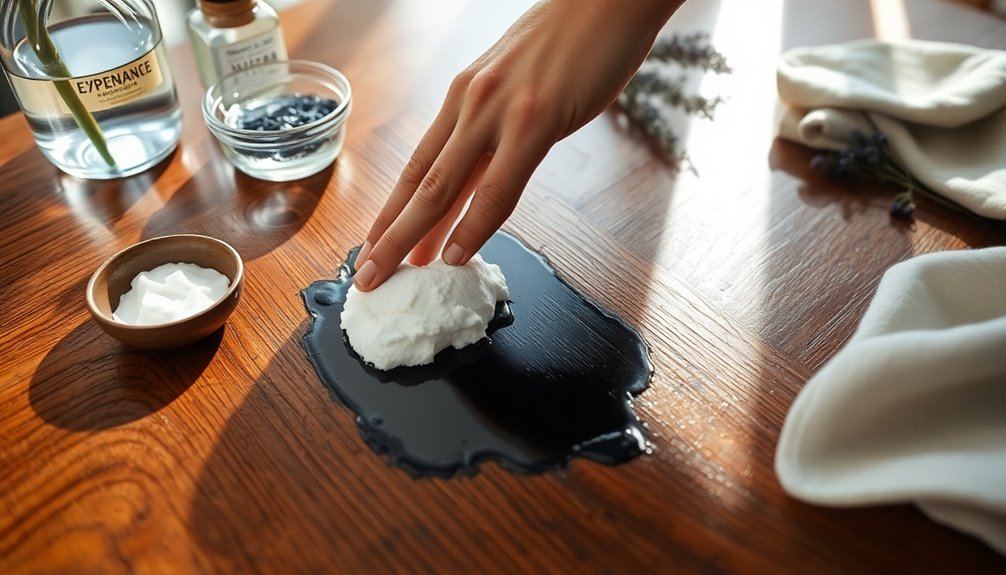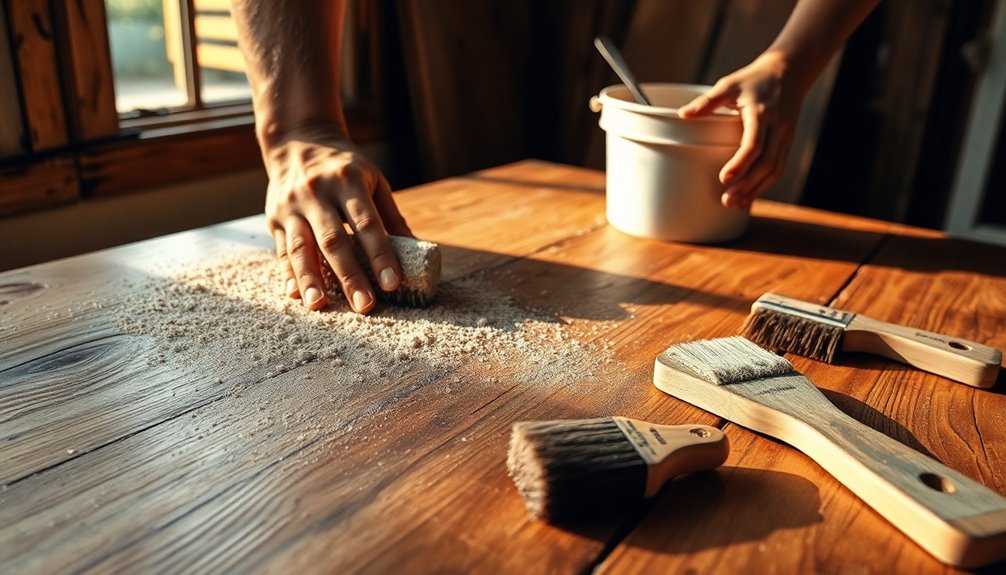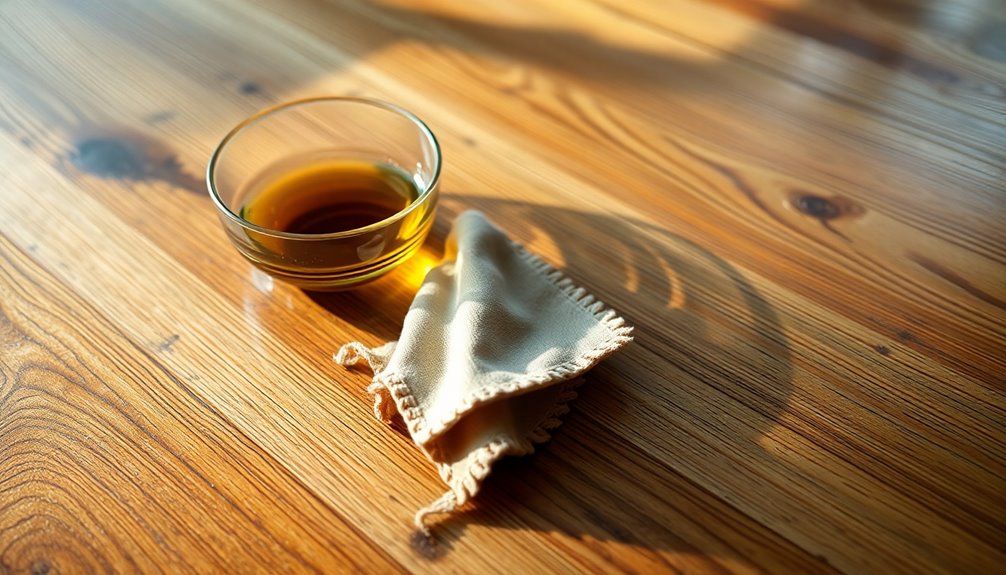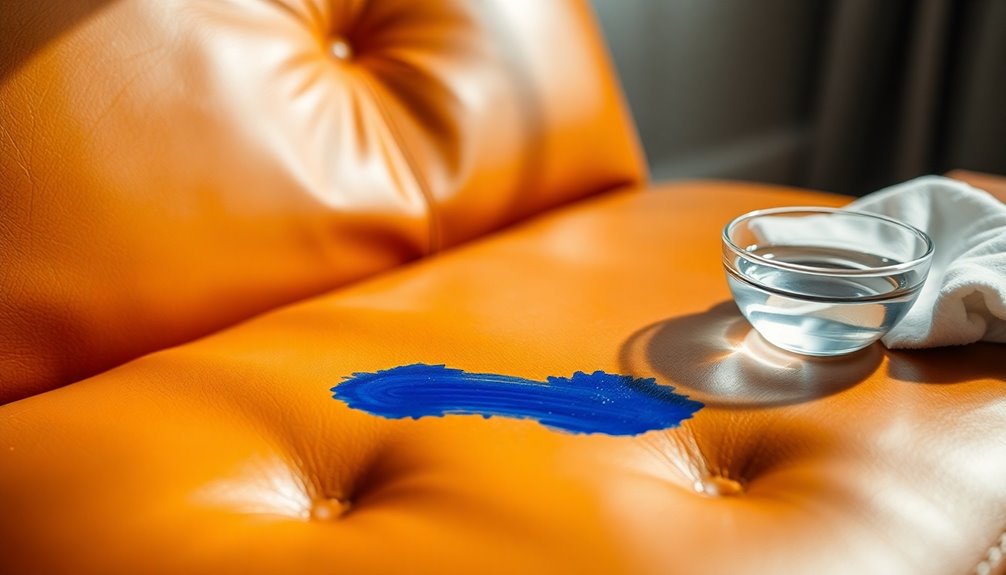To remove stains from wood furniture, start by preparing your workspace with drop cloths and ensuring good ventilation. You can use chemical strippers, applying them with a natural fiber brush, letting them sit until they bubble. Alternatively, try household solutions: mayonnaise works well if you leave it on for a few hours. Baking soda mixed with water forms a paste for tough stains. For deeper scratches, sanding with medium to fine grit sandpaper will help smooth the surface. By following these steps, you can restore your furniture's appearance and find out more tips along the way.
Key Takeaways
- Use chemical strippers for stubborn stains, applying them evenly and allowing them to sit for 15-20 minutes before scraping off residue.
- For light stains, try natural oils like mineral oil or mayonnaise, letting them sit for several hours to lift the stain.
- Drench paper towels in vinegar and leave them on sticky stains for 30-45 minutes for effective removal.
- Sand the stained area with medium grit sandpaper, progressing to finer grits for a smooth finish while following the wood grain.
- Clean the surface thoroughly before applying a new finish to ensure optimal adhesion and appearance.
Preparation and Safety

Before diving into stain removal, it's essential to prioritize your workspace and personal safety. Start by laying down drop cloths or thick contractor's paper to protect your floors. Make sure to clear the area around your furniture to prevent spills and debris from causing a mess. Adequate ventilation is vital, especially when you're working with any chemical agents, so open windows or turn on fans. Tape off metal pulls and hinges to avoid unwanted contact with those chemicals, and use metal or glass containers for your rags and steel wool to prevent damage to plastic.
For your personal safety, wear industrial-strength, chemical-resistant gloves. Don't forget goggles and a face mask to shield yourself from caustic chemicals. Dress in old clothes that you won't mind getting ruined. If your gloves start to buckle or have holes, replace them immediately to avoid skin irritation. Additionally, it's advisable to work with your stain removal agent in a well-ventilated area to minimize exposure to strong chemicals.
Before you start removing stains, clean the surface by wiping away dust and dirt with mild soap and water. Let the furniture dry thoroughly, and ensure there's no residual dirt left, as this will help you avoid scratches during the cleaning process.
Using Chemical Strippers

Chemical strippers are often the most effective way to tackle stubborn stains on wood furniture. You'll find two main types: solvent and caustic strippers. Solvent strippers are powerful and ideal for thick layers of stain but emit strong fumes and pose a fire risk. On the other hand, caustic strippers are less potent, easier to use, and work well on many types of wood, especially with latex stains. Always check that the product is compatible with your wood type and read the manufacturer's instructions before use.
To apply, use a natural fiber paintbrush and work in small sections, applying a thick, even layer. Make sure the stripper gets into all nooks and crannies. Let it sit for 15-20 minutes until the finish bubbles up, and ensure you're in a well-ventilated area. When it's time to remove the stain, use a putty knife or plastic scraper, gently lifting the residue in the direction of the wood grain. If the stripper dries, reapply it. In addition, remember to select a well-ventilated area to ensure safety while working with chemical strippers. Finally, clean up any remaining traces with steel wool pads or scrubbing pads and mineral spirits for a thorough finish.
Alternative Household Solutions

Exploring alternative household solutions can be an effective way to tackle stains on wood furniture without harsh chemicals. One easy method is to use natural oils. For instance, rubbing mineral oil into the stain with a soft rag can help. Just let it sit for a while to penetrate. Mayonnaise is another surprising option; apply it to the stain and let it sit for a few hours to displace moisture and nourish the wood.
If you're dealing with sticky stains, try vegetable oil, letting it sit overnight. For a more abrasive approach, mix baking soda with water to form a paste, gently rub it into the stain, and wipe it off after a few minutes. A vinegar soak using paper towels can also work wonders—just drench them and leave them on the stain for 30-45 minutes. Wood stains can be caused by various factors, including moisture and food, making it essential to choose the right household solution for effective removal.
Don't overlook common items like non-gel toothpaste or a hairdryer to tackle water stains. You can also combine ingredients, like mixing lemon juice and vinegar for an effective stain-lifting solution. These methods can help restore your wood furniture without harmful chemicals.
Sanding and Smoothing

After trying out alternative household solutions for stain removal, you might find that some stains require a more hands-on approach. Sanding is an effective way to tackle stubborn stains and smooth the surface of your wood furniture. Start with medium grit sandpaper, around 80-150 grit, to remove old paint or stain. Once you've stripped away the bulk, switch to 120 grit to blend any remaining stain. If you're still having trouble, apply CitriStrip Stripping Gel, cover it with plastic wrap, and let it sit for 30 minutes to an hour before scrubbing it off with hot water and soap. For particularly stubborn areas, you may need to repeat this process.
Once the stains are gone, it's time to smooth the wood. Use fine grit sandpaper (180-220 grit) for general smoothing and finish with 320-grit sandpaper for a polished surface. Remember to sand in the direction of the wood grain to avoid scratches. After sanding, use pressurized air to eliminate dust thoroughly before proceeding to any finishing steps. Taking your time with each stage will ensure a beautiful, even result.
Applying a New Finish

To achieve a fresh, polished look for your wood furniture, applying a new finish is essential. Start by preparing the surface; clean off any dust and dirt with a tack cloth or brush. Use a cleaner or degreaser to eliminate oils and substances that could interfere with adhesion. Make sure the surface is dry before proceeding.
Choose a finish that suits your wood type and desired appearance. Always follow the manufacturer's instructions for application. Apply the finish evenly using a brush, rag, or spray, working in the direction of the grain to prevent brush marks. It's best to apply multiple thin coats, letting each coat dry completely before adding the next. A second coat enhances durability, so be sure to include that in your application process.
Mix your finish thoroughly to avoid settled materials, and remember, thick coats can lead to uneven drying and dust attraction. Use the "tip off" method at a 45-degree angle to minimize bubbles. After the final coat dries for at least 24 hours, lightly sand the surface to smooth out imperfections. Finally, buff the surface with fine steel wool or quality wood polish for an enhanced look, ensuring it's fully dry before use.
Frequently Asked Questions
How Can I Prevent Future Stains on My Wood Furniture?
To prevent future stains on your wood furniture, start by applying a protective finish like polyurethane or lacquer. Use tablecloths, coasters, and hot pads to shield surfaces from spills. Keep your furniture in a controlled environment, avoiding areas with high humidity or direct sunlight. Regularly clean and polish your furniture with suitable products, and inspect it for any signs of wear or damage. Taking these steps will help maintain your wood’s beauty and integrity. Additionally, consider using natural oils, such as tung or linseed oil, to nourish and protect your wood. If you’re looking to refresh the appearance of your pieces, explore more options like lightening dark wood furniture tips that can enhance the color while preserving the wood’s structure. Remember that consistency in care will yield the best results, keeping your furniture looking stunning for years to come.
Is It Safe to Use Bleach on Wood Stains?
Using bleach on wood stains can be effective, but you need to proceed with caution. Household bleach is generally safe for removing certain stains without altering the wood's natural color. However, two-part bleach can lighten the wood significantly, so be careful if you want to maintain its original hue. Always wear gloves and goggles, work in a well-ventilated area, and neutralize the wood afterward to stop the bleaching process.
What Tools Are Best for Applying Chemical Strippers?
When you're applying chemical strippers, a natural fiber-bristled paintbrush is your best bet for a thin, even coat. For tougher jobs, use a putty knife to apply thicker layers and scrape off loosened material, always moving with the wood grain. Don't forget to protect your workspace with drop cloths and ensure proper ventilation. Safety gear like gloves and masks is essential to keep you safe from fumes and potential hazards.
How Long Should I Wait Between Sanding and Finishing?
You should wait at least 24 hours between sanding and finishing. This allows the wood to dry completely and ensures any dust or residue is gone. After sanding, wipe the surface with a tack cloth to remove dust. If you're using mineral spirits, let it dry as well before applying your finish. Rushing this step can lead to a poor finish, so patience is key for achieving the best results.
Can I Remove Stains Without Damaging the Wood Finish?
Yes, you can remove stains without damaging the wood finish, but it requires care. Start by identifying the stain's type and testing any cleaning solution on a hidden spot. Use gentle natural remedies like baking soda paste or vinegar-soaked paper towels. Avoid abrasive materials to prevent scratches. If needed, opt for chemical strippers, always following safety precautions. Finally, polish and condition the wood to restore its shine after stain removal.
Conclusion
In conclusion, removing stains from wood furniture doesn't have to be a daunting task. With the right preparation and methods, whether you choose chemical strippers or household solutions, you can restore your furniture's beauty. Don't forget to sand and smooth the surface before applying a new finish for a professional look. By following these steps, you can breathe new life into your wood pieces and enjoy them for years to come. Happy restoring!









